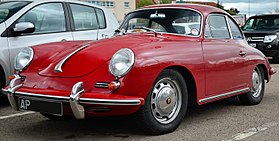Porsche 356
| Porsche 356 | |
|---|---|

Porsche 356 C coupé
|
|
| Overview | |
| Manufacturer |
|
| Production | 1948–1965 |
| Designer | Erwin Komenda |
| Body and chassis | |
| Class | Sports car (S) |
| Body style |
|
| Layout | Rear-engine, rear-wheel-drive |
| Dimensions | |
| Wheelbase | 82.7 in (2,100 mm) |
| Length | 152.4–157.9 in (3,870–4,010 mm) |
| Width | 65.4 in (1,660 mm) |
| Height | 48.0–51.8 in (1,220–1,320 mm) |
| Curb weight | 1,700–2,296 lb (771–1,041 kg) |
| Chronology | |
| Successor | Porsche 911/912 |
| Porsche 356 | |
|---|---|

1954 Porsche 356, showing the V-shaped front windshield
|
|
| Overview | |
| Production | 1948–1955 |
| Powertrain | |
| Engine |
|
| Transmission | four-speed manual |
| Porsche 356 A | |
|---|---|
 |
|
| Overview | |
| Production | 1955–1959 |
| Powertrain | |
| Engine |
|
| Transmission | four-speed manual |
| Porsche 356 B | |
|---|---|
 |
|
| Overview | |
| Production | 1960–1963 |
| Powertrain | |
| Engine |
|
| Transmission | four-speed manual |
| Porsche 356 C | |
|---|---|

Porsche 356 C cabriolet
|
|
| Overview | |
| Production | 1964–1965 |
| Powertrain | |
| Engine |
|
| Transmission | four-speed manual |
The Porsche 356 is a luxury sports car which was first produced by Austrian company Porsche Konstruktionen GesmbH (1948–1949), and then by German company Dr. Ing. h. c. F. Porsche GmbH (1950–1965). It was Porsche's first production automobile. Earlier cars designed by the Austrian company include Cisitalia Grand Prix race car, the Volkswagen Beetle, and Auto Union Grand Prix cars.
The 356 is a lightweight and nimble-handling, rear-engine, rear-wheel drive, two-door, sports car available in hardtop coupé and open configurations. Engineering innovations continued during the years of manufacture, contributing to its motorsports success and popularity. Production started in 1948 at Gmünd, Austria, where approximately 50 cars were built. In 1950 the factory relocated to Zuffenhausen, Germany, and general production of the 356 continued until April 1965, well after the replacement model 911 made its autumn 1963 debut. Of the 76,000 originally produced, approximately half survive.
Prior to World War II Porsche designed and built three Type 64 cars for a 1939 Berlin-to-Rome race that was cancelled. In 1948 the mid-engine, tubular chassis 356 prototype called "No. 1" was completed. This led to some debate as to the "first" Porsche automobile, but the 356 is considered by Porsche to be its first production model.
The 356 was created by Ferdinand "Ferry" Porsche (son of Ferdinand Porsche, founder of the German company), who founded the Austrian company with his sister, Louise. Like its cousin, the Volkswagen Beetle (which Ferdinand Porsche Sr. had designed), the 356 is a four-cylinder, air-cooled, rear-engine, rear-wheel drive car with unitized pan and body construction. The chassis was a completely new design as was the 356's body which was designed by Porsche employee Erwin Komenda, while certain mechanical components including the engine case and some suspension components were based on and initially sourced from Volkswagen. Ferry Porsche described the thinking behind the development of the 356 in an interview with the editor of Panorama, the PCA magazine, in September 1972. "….I had always driven very speedy cars. I had an Alfa Romeo, also a BMW and others. ….By the end of the war I had a Volkswagen Cabriolet with a supercharged engine and that was the basic idea. I saw that if you had enough power in a small car it is nicer to drive than if you have a big car which is also overpowered. And it is more fun. On this basic idea we started the first Porsche prototype. To make the car lighter, to have an engine with more horsepower…that was the first two seater that we built in Carinthia (Gmünd)".
...
Wikipedia
